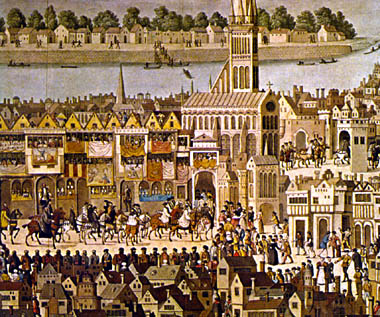
from Society of Antiquaries, Vetusta Monumenta
If the ancient folkmoot was at least a theoretically participative gathering, at the opposite chronological end of the Middle Ages community involvement in local government was more characterized by civic processions. Here the role of the community was more passive – at the most, re-active rather than pro-active.
Civic processions were a vehicle for expression of conspicuous socio-political superiority. As such they naturally suited the ruling class more, for the purpose was to foster the sense of political (comm)unity as well as feelings of civic pride, without allowing any meaningful involvement on the part of the populace, other than ritualistic. The role of the populace was to be essentially supportive, in witnessing and thereby approving – or at least acquiescing in – the status quo of power and hierarchy, as displayed through elements of a procession, such as order of appearance, costume, and incorporation of other symbols.
Religious processions held on festivals such as Corpus Christi gave support to the same philosophy, accommodating the display of socio-political differentiation within the community and thereby appearing to give it the blessing of the Church.
Whereas the folkmoot was at least a somewhat egalitarian gathering, if at risk of becoming a free-for-all, the procession established a division between audience and players, rulers and ruled, leaders and followers (although in actual fact some processions were structured in a reverse order of status). It also aimed at communicating and reinforcing the values of orderliness and decorum. In other words, at infusing the community with the political philosophy of the urban patriciate – one that emphasized leaving government to those who were equal to the task, in terms of authority, wealth and wisdom. This philosophy, by no means alien to the ruled, was being implemented in constitutional developments in the larger towns during the same period of the late fourteenth and fifteenth centuries.
The illustration above is an extract from a depiction of the coronation-eve procession of Edward VI, from the Tower to Westminster Abbey. The section here appears to represent West Cheap, with the procession turning south to head around the southern side of St. Paul's before exiting the city through Ludgate (far right), then continue along Fleet Street and the Strand.
Although the example is post-medieval and a national rather than local event, pre-coronation processions through London were a long-standing tradition. Civic processions associated with the annual ceremonies surrounding the swearing-in of a new administration likely had a similar character, with crowds watching from streets and windows and houses decorated with cloths hung out. The intended effect of all the pomp and ceremony was to impress both the populace and any viewing men of influence from outside the town, and convey the notion that those who were the centre of attention were fitted for rule.
In precocious London we see both civic processions and the philosophy of rule developing in the thirteenth century, the procession of the newly-elected mayor from the city to Westminster to take his oath of office before the king's representative was initially more of an obligation than an occasion for ceremony. But by the end of the fourteenth century, the mayor and his peers (the aldermen) had been joined on the procession by the leading members of the craft gilds, dressed in their company liveries, and this participation later became obligatory; a feast, minstrelsy, and pageants were incorporated in the fifteenth century.